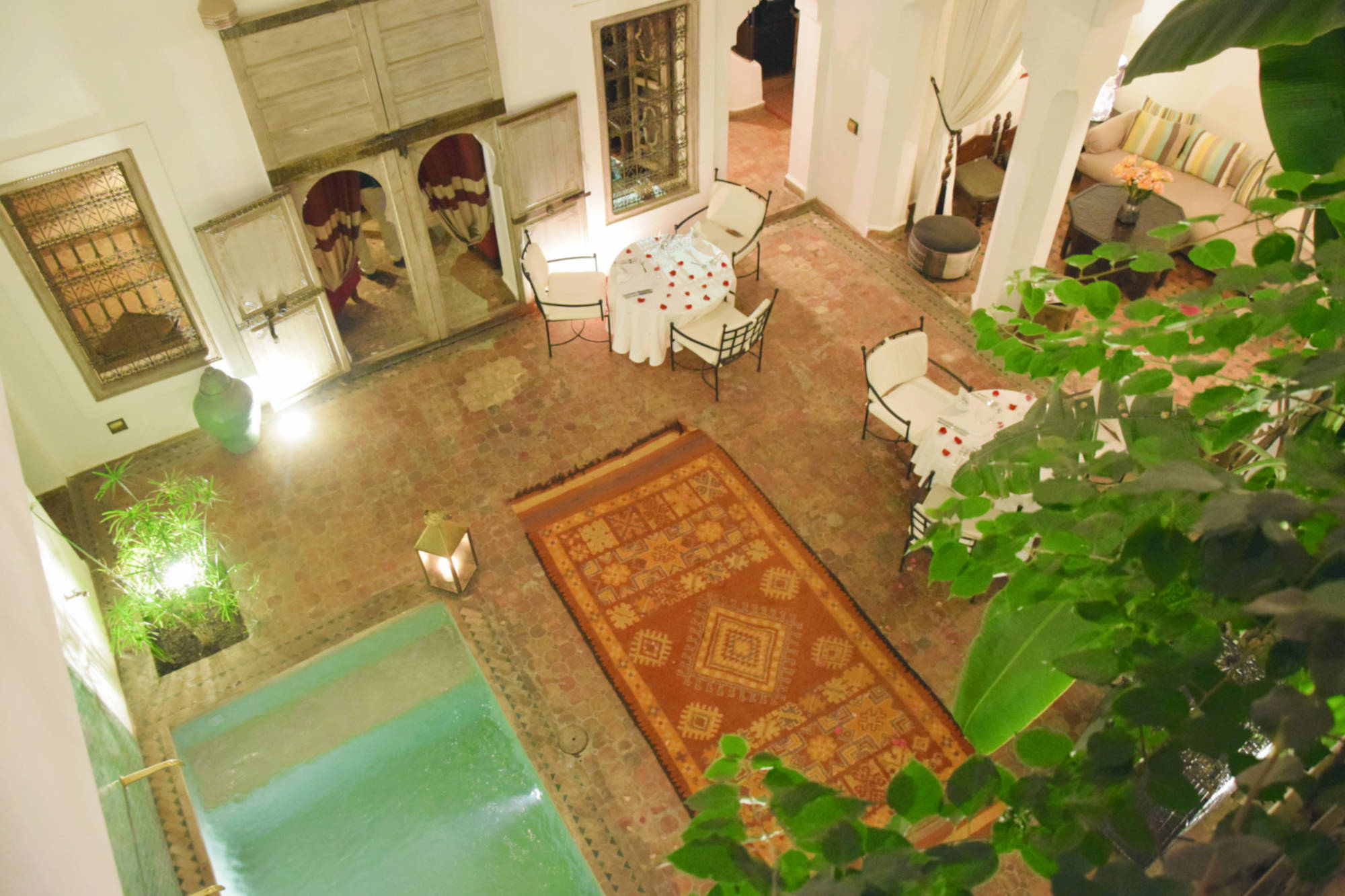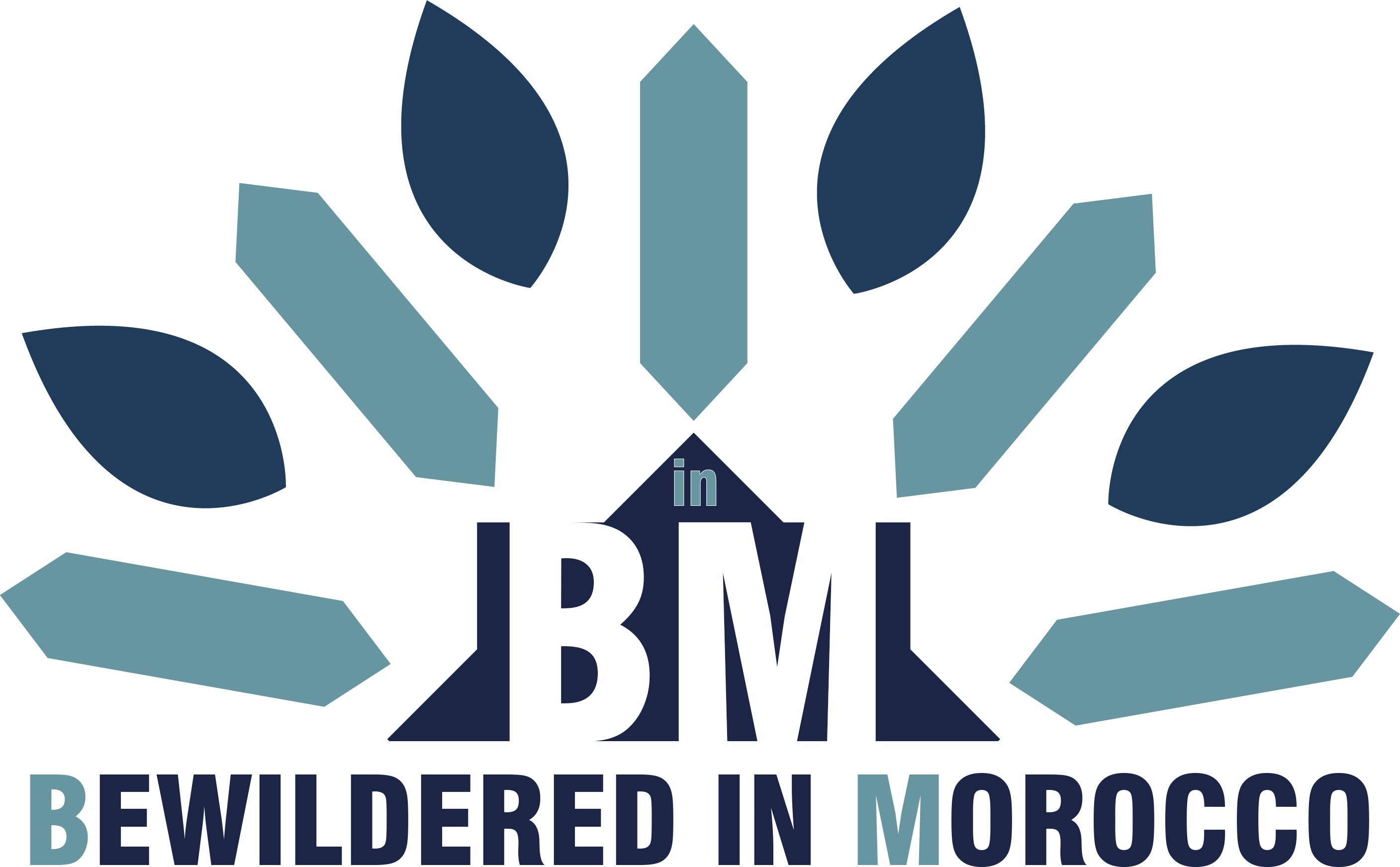When I first moved to Morocco, the maze-like medinas confused me. Narrow alleyways twisting in all directions, walls with no windows, and plain doors that gave no hint of what lay behind them. But one day, a friend invited me to his family's riad in Marrakech. As he pushed open that heavy wooden door, I was transported to another world. The noise of the street vanished, replaced by the gentle trickle of water. Sunlight streamed down from above, illuminating intricate tile work and lush plants. At the center of it all was the patio – the heart and soul of every traditional Moroccan riad.
Today, I want to take you behind those mysterious doors and reveal why the central patio is the magical secret that makes riads so special. Whether you're planning a trip to Morocco or just daydreaming about exotic destinations, understanding this unique architectural feature will deepen your appreciation of Moroccan culture and design.
What Exactly Is a Riad?
Before we dive into the patios, let's clarify what makes a riad different from other buildings. A traditional Moroccan riad is a multi-story home built around a central courtyard or garden. The word "riad" comes from the Arabic term "ryad," meaning garden. These homes were historically owned by wealthy merchants and nobles, though today many have been converted into boutique hotels and guesthouses.
What makes riads unique is their inward-facing design. From the outside, you might see nothing but plain walls and a simple door. All the beauty is hidden within – a perfect reflection of Moroccan values that prize privacy and family life over external appearances.
The Cultural Significance: Why Riads Turn Inward

When I walk through Morocco's ancient medinas, I'm always struck by how the buildings seem to huddle together, sharing walls but revealing very little of themselves to the street. This isn't accidental – it's deeply rooted in Moroccan culture.
Riads were designed to be "fermées sur l'extérieur" (closed off from the outside world) for two important reasons:
1. Preserving Family Privacy and Intimacy
In traditional Moroccan culture, family life is sacred and private. The home is a sanctuary where family members, especially women, could relax without the scrutiny of the public eye. The high walls and inward-facing rooms ensured that daily life remained sheltered from neighbors and passersby.
Even today, when I visit Moroccan friends in their traditional homes, there's a clear separation between the public areas where guests are received and the private family spaces. The central patio often serves as a middle ground – a place where the family gathers but can also entertain trusted visitors.
2. Protection from Morocco's Harsh Climate
Have you ever experienced a summer day in Marrakech? The heat can be overwhelming! The clever riad design creates a natural defense against Morocco's extreme temperatures. Those thick, windowless exterior walls act as barriers, keeping the scorching heat out during summer and retaining warmth during winter nights.
The Architectural Genius: How the Central Patio Works
The central patio isn't just beautiful – it's a brilliant example of natural climate control that worked centuries before air conditioning was invented.
Natural Air Conditioning System
The patio creates what architects call a "chimney effect." Hot air rises and escapes through the open roof, pulling cooler air into the building. This continuous air circulation helps maintain a comfortable temperature throughout the home.
I remember visiting a friend's riad during a heatwave in Fez. The temperature outside was nearly 40°C (104°F), but inside, gathered around the central patio, we enjoyed a pleasant breeze and temperatures that must have been at least 10 degrees cooler. No electricity needed – just clever design working with natural principles!
A Peaceful Living Space
Beyond temperature regulation, the central patio creates an "espace de vie paisible" – a peaceful living space that serves as the heart of family life. Surrounded by rooms on all sides and open to the sky above, it offers privacy while still connecting inhabitants to nature.
The patio typically features:
- Beautiful zellige (geometric tile work)
- Carved plaster designs (tadelakt)
- Lush greenery and potted plants
- Comfortable seating areas
- And often, a central fountain
Water: The Soul of the Riad
Speaking of fountains, water plays a crucial role in Moroccan architecture and culture. In a country where much of the landscape is arid, water represents "la source de vie" (the source of life) and "le bien-être" (well-being).
The fountain in a riad's central patio isn't just decorative. Its gentle bubbling adds another sensory dimension to the space – the soothing sound of flowing water creates a feeling of tranquility that's hard to describe until you've experienced it.
I once stayed in a 300-year-old riad in Marrakech during a writing retreat. Every morning, I would sit by the fountain with my notebook, listening to the water while working. Something about that gentle sound helped clear my mind and inspire creativity. It's no wonder Moroccan culture values water so deeply – it truly transforms a space.
From Historical Necessity to Modern Luxury
Today, these architectural features that were born from necessity and cultural values have become the very reason riads are so sought after. Both locals and international investors recognize their unique charm.
Modern riads often maintain the traditional central patio design while adding contemporary comforts:
- Plunge pools or expanded fountain features
- Retractable covers for the open roof (for rainy days)
- Modern lighting to highlight architectural details
- Luxurious furnishings that blend traditional Moroccan style with contemporary comfort
My Personal Experience: The Magic of Entering a Riad
Let me share a memory that perfectly captures the riad experience. Last year, I was guiding some friends through the chaotic souks of Marrakech. After hours of navigating narrow alleys filled with vendors, motorcycles, donkey carts, and thousands of people, we were all feeling overwhelmed by the sensory overload.
Then we arrived at our riad. From outside, it was just another blank wall with a modest wooden door. But when our host opened that door, my friends actually gasped. We stepped from chaos into complete tranquility. The central patio was bathed in dappled sunlight, flowering plants climbed the walls, and a small fountain created a gentle melody in the center.
"It's like stepping into another dimension," my friend whispered. And she was right. That's the magic of the riad – the dramatic contrast between the vibrant energy of Moroccan street life and the peaceful sanctuary within.
Tips for Experiencing Authentic Riads in Morocco
If you're planning a trip to Morocco, staying in a traditional riad should be high on your list. Here are some tips to help you choose the perfect one:
Location Matters
Riads are found in the historic medinas of most Moroccan cities, but each city offers a different experience:
- Marrakech: Known for luxurious riads with elaborate decoration
- Fez: Features some of the oldest and most historically significant riads
- Essaouira: Offers riads with a unique blend of Moroccan and Portuguese influences
- Chefchaouen: Famous for its blue-painted riads that match the city's azure streets
What to Look For
When booking a riad experience, consider:
- Does it have an authentic central patio with traditional features?
- Is it family-owned and operated? These often provide the most authentic experience
- Are meals offered? Riads often serve some of the best home-cooked Moroccan food
- How many rooms? Smaller riads (4-6 rooms) tend to offer a more intimate experience
Respecting the Space
Remember that riads were designed for tranquility. When staying in one:
- Keep noise levels reasonable, as sound carries easily around the central patio
- Respect private areas of the house if staying in a family-operated riad
- Take time to actually enjoy the central patio – don't just use your riad as a place to sleep!
The Architectural Elements That Make Riad Patios Special
For those interested in design and architecture, here are some features to look for in traditional riad patios:
Zellige Tilework
These intricate geometric mosaics require incredible craftsmanship. Artisans cut thousands of individual pieces by hand and assemble them into complex patterns. You'll find zellige on floors, fountains, and often climbing partway up the walls.
Carved Plasterwork (Gebs)
Above the tile work, look for ornate plaster carving featuring geometric patterns, Arabic calligraphy, and floral designs. The best examples are so delicate they look like lace.
Cedar Wood Elements
Cedar from the Middle Atlas Mountains is used for structural elements like beams and columns, as well as for decorative ceilings and railings. Look for intricate painting and carving.
The Fountain
Central fountains vary from simple marble basins to elaborate multi-tiered designs. The sound of water is as important as the visual element.
Beyond the Riad: How Central Patios Influenced Other Moroccan Architecture
The concept of the central courtyard isn't unique to riads – it has influenced many types of Moroccan buildings:
Madrasas (Islamic Schools)
Historic madrasas like the Ben Youssef in Marrakech feature spectacular central courtyards that served both practical purposes (light, air circulation) and symbolic ones (representing the center of knowledge).
Fondouks (Historic Merchant Inns)
These commercial buildings where traveling merchants would stay with their goods also featured central courtyards, allowing traders to socialize while keeping their animals and wares secure.
Modern Moroccan Homes
Even many contemporary Moroccan homes incorporate some version of the central patio concept, though often in modified form to accommodate modern lifestyles.
The Enduring Appeal of Riad Patios
What fascinates me most about traditional riads is how relevant their design principles remain today. In an era of climate change and energy concerns, these centuries-old buildings offer lessons in sustainability, natural climate control, and creating peaceful living spaces.
The central patio of a riad isn't just a historical curiosity – it's a timeless solution to universal human needs: comfort, privacy, beauty, and connection to nature. That's why riads continue to captivate both Moroccans and visitors alike.
Next time you're planning a trip to Morocco, remember that the most authentic experience often hides behind an unassuming door. Step inside a traditional riad, find a comfortable spot by the fountain in the central patio, and take a moment to appreciate the genius of this architectural tradition that transforms simple elements – water, light, plants, and craftsmanship – into a multisensory sanctuary.
Have you ever stayed in a Moroccan riad? What was your experience of the central patio? Or is visiting one on your travel bucket list? Share your thoughts and questions in the comments below!
Looking for more unique Moroccan experiences? Check out my guides to hammam bath rituals, mountain trekking in the Atlas, or navigating Moroccan souks. And don't forget to subscribe for more insights into Morocco's rich culture and hidden treasures!
Frequently Asked Questions About Moroccan Riads
While similar courtyard homes exist throughout the Islamic world, the specific style known as a "riad" with its central water feature and garden is distinctly Moroccan.
Yes! Many riads operate as restaurants or cafes, allowing visitors to experience the architecture without booking a room. Some historic riads also function as museums, particularly in Fez and Marrakech.
Riads are designed to be comfortable year-round, but spring (March-May) and fall (September-November) offer the most pleasant temperatures. During these seasons, you can fully appreciate how the patio regulates temperature naturally.
It depends on the specific riad. Some welcome families and have rooms that can accommodate children, while others cater primarily to couples and may have age restrictions. The open central patio can be a concern for families with very young children.
